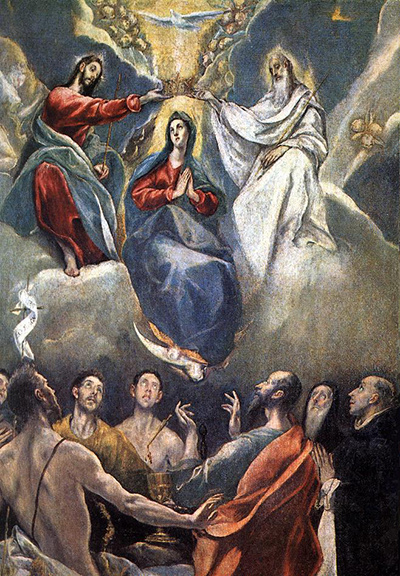In this painting, Mary is the epicentre of the picture with God on the right, Christ on the left and The Holy Spirit between the two to form the Holy Trinity.
Though various artists have produced the painting in different forms, El Greco's work maintains its authenticity. The composition produces an inverted triangle but also adopts the shape of a heart. God, the Father, takes on the figure of an old man to symbolise wisdom while the Holy Spirit is portrayed in a rather old form traditional of a white dove.
El Greco brings out his artistic elongation of pictures by presenting the three persons at the same height, which in reminiscent of the equality within the Holy Trinity. The Cherubs are drawn at the bottom of the painting. He uses blues and violets to paint the garments instead of the conventional red to symbolise heavenly grace and royalty. The Virgin Mary wears a blue cloak to signify good health, hope and a state of servitude.
Born in 1541, El Greco descended from a wealthy urban family that had been rendered homeless after a revolt against the Catholic Venetians. He received his first training as a portrait painter at Cretan School. El Greco's early works in Crete include Dormition of The Virgin (1567), The Adoration of the Magi, and St. Luke Painting the Virgin and Child after which he left for Venice and never went back to Crete. His whereabouts while in Venice are limited, though a letter addressed to him by Clovio, an old friend of El Greco defined his work as a rare gem in painting. El Greco later (1570) moved to Rome where he worked on a series of paintings that demonstrated his Venetian training.
After interacting with the city's intellectual elite, he altered his distinctive style and took to the then-Venetian Renaissance style by executing flexible, elongated compositions. In 1577 he moved to Toledo in Spain where he worked on most of his mature works like The Assumption of The Virgin and The Trinity for the Cathedral of Toledo. It was here that he received the commission for The Burial of the Count of Orgaz, his best-known painting and several other major commissions among them the Coronation of the Virgin. El Greco died on 7th April 1614 after he fell ill while executing a commission for the Hospital Tavera.
El Greco's principle style is characterised by imagination and intuition over the primary subject of creation. He abandoned the classicist criteria of measure and proportion and believed grace was the supreme impetus of art. He also regarded colour as a prime factor of any painting. El Greco's mature works exuded a natural inclination to dramatise rather than describe. As such, his high spiritual sentiments transfer from the picture directly to the audience. Pacheo, however, observed that he sometimes adopted a rather casual, violent and perturbed style in a bid to acquire a characteristic style.
El Greco's works also demonstrate exceptionally tall, slender silhouettes and stretched out compositions that served his expressive and aesthetic ideologies that defied the laws of nature. Another distinctive feature of his mature style is the use of light. Agustin Bustamante Garcia and Fernando Marias (scholars who transcribed El Greco's notes) connect the painter's use of light with his Christian Neo-Platonism ideologies as it was a time El Greco was immersed in the religious environs of Spain.
Commissioned by Santo Domingo el Antiguo in Spain, El Greco created the painting that was to be hung in the loft of the High Altarpiece. The painting shows Jesus Christ ascending to heaven after his great commission on earth where six grieving angels keep an eye on his body while small cherub faces gather at his feet. El Greco captures the dead weight of Christ body with such dexterity using his characteristic elongation of figures.
The picture's dark colours at the bottom are used to symbolise mortality while the bright yellow sky above signifies heaven. It was displayed above one of his other collections The Assumption (completed in 1577). The piece received tribute from Santo Domingo el Antiguo and other artists from numerous other commissions that gave him a prosperous career. He completed the piece on 1578 after which he never painted another picture of this genre again.




